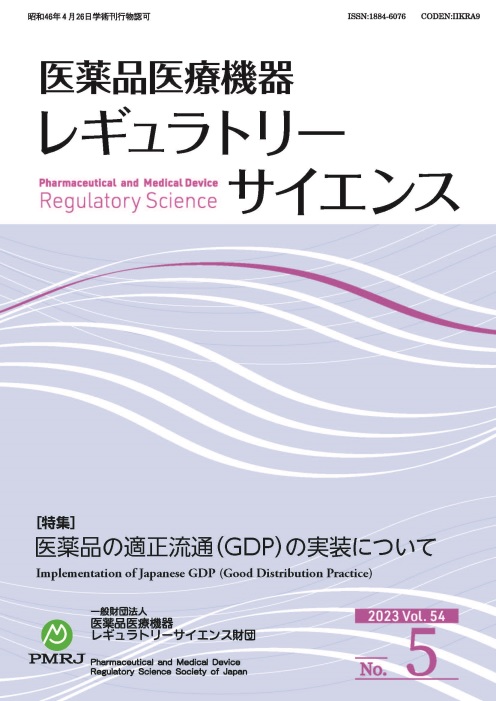54 巻, 5 号
選択された号の論文の17件中1~17を表示しています
- |<
- <
- 1
- >
- >|
特集 医薬品の適正流通(GDP)の実装について
-
2023 年54 巻5 号 p. 372-379
発行日: 2023年
公開日: 2023/10/27
PDF形式でダウンロード (839K) -
2023 年54 巻5 号 p. 380-385
発行日: 2023年
公開日: 2023/10/27
PDF形式でダウンロード (641K) -
2023 年54 巻5 号 p. 386-394
発行日: 2023年
公開日: 2023/10/27
PDF形式でダウンロード (1519K) -
2023 年54 巻5 号 p. 395-399
発行日: 2023年
公開日: 2023/10/27
PDF形式でダウンロード (424K) -
2023 年54 巻5 号 p. 400-406
発行日: 2023年
公開日: 2023/10/27
PDF形式でダウンロード (24281K)
今月のTopic 規制
-
2023 年54 巻5 号 p. 407-410
発行日: 2023年
公開日: 2023/10/27
PDF形式でダウンロード (650K) -
2023 年54 巻5 号 p. 411-416
発行日: 2023年
公開日: 2023/10/27
PDF形式でダウンロード (362K)
今月のTopic 開発
-
2023 年54 巻5 号 p. 417-420
発行日: 2023年
公開日: 2023/10/27
PDF形式でダウンロード (333K)
今月のTopic 再生医療
-
2023 年54 巻5 号 p. 421-423
発行日: 2023年
公開日: 2023/10/27
PDF形式でダウンロード (258K)
今月のTopic 医療機器
-
2023 年54 巻5 号 p. 424-427
発行日: 2023年
公開日: 2023/10/27
PDF形式でダウンロード (254K)
投稿 原著
-
2023 年54 巻5 号 p. 428-438
発行日: 2023年
公開日: 2023/10/27
PDF形式でダウンロード (1620K) -
2023 年54 巻5 号 p. 439-454
発行日: 2023年
公開日: 2023/10/27
PDF形式でダウンロード (634K)
投稿 資料
-
2023 年54 巻5 号 p. 455-471
発行日: 2023年
公開日: 2023/10/27
PDF形式でダウンロード (479K)
財団Information 研修会プロシーディング
-
2023 年54 巻5 号 p. 472-474
発行日: 2023年
公開日: 2023/10/27
PDF形式でダウンロード (231K) -
2023 年54 巻5 号 p. 475-478
発行日: 2023年
公開日: 2023/10/27
PDF形式でダウンロード (263K) -
2023 年54 巻5 号 p. 479-489
発行日: 2023年
公開日: 2023/10/27
PDF形式でダウンロード (354K)
財団Information 報告書
-
2023 年54 巻5 号 p. 490-498
発行日: 2023年
公開日: 2023/10/27
PDF形式でダウンロード (29504K)
- |<
- <
- 1
- >
- >|
